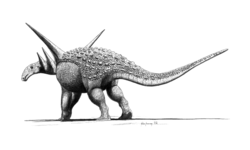Sauropelta
Sauropelta was an armoured dinosaur from the Lower Cretaceous. It looked a lot like its more advanced relative Ankylosaurus, but didn't have the bony nodes at the end of its tail.
| Sauropelta Temporal range: Lower Cretaceous
| |
|---|---|

| |
| Scientific classification | |
| Kingdom: | |
| Phylum: | |
| Class: | |
| Superorder: | |
| Order: | |
| Suborder: | |
| Infraorder: | |
| Family: | |
| Genus: | Sauropelta
|

Anatomically, Sauropelta is one of the best-understood nodosaurids, with fossilized remains recovered in the U.S. states of Wyoming, Montana, and possibly Utah. It is also the earliest known genus of nodosaurid; most of its remains date to about 115 to 110 million years ago.
It was a medium-sized nodosaurid, measuring about 5 meters (16.5 ft) long. Sauropelta had a distinctively long tail which made up about half of its body length. Although its body was smaller than a modern black rhinoceros, Sauropelta was about the same mass, weighing in at about 1,500 kilograms (3,300 lb). The extra weight was largely due to its extensive armour, including the large spines projecting from its neck.
As in other ankylosaurs, thick triangular scutes projected above and behind the eyes, as well as below and behind the eyes.[1] More typically for nodosaurids, leaf-shaped teeth lined both upper and lower jaws, used for cutting plant material. The front end of the skull is unknown, but there would have been a keratinous beak.[2]
References
change- ↑ Carpenter, Kenneth & Kirkland, James I. 1998. Review of Lower and Middle Cretaceous Ankylosaurs from North America. In Lucas, Spencer G.; Kirkland, James I; & Estep, J.W. (eds) Lower and Middle Cretaceous Ecosystems. New Mexico Museum of Natural History and Science Bulletin #14, 249–270.
- ↑ The dinosauria (2nd ed.). Berkeley, Calif.: University of California Press. 2007. ISBN 978-0-520-25408-4. OCLC 154697781.